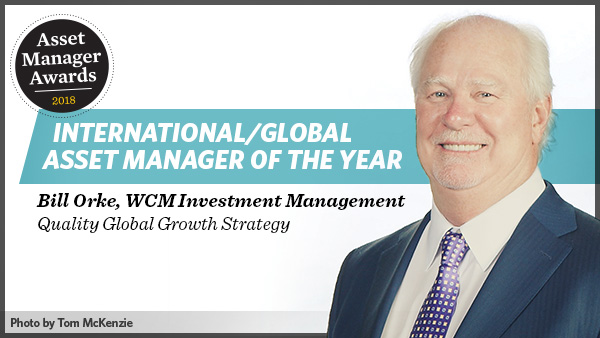 Bill Orke
Bill Orke
WCM Quality Global Growth Strategy includes about 30-35 holdings. “The crux of WCM’s investment process lies in its ability to identify companies that possess a demonstrable competitive advantage over peers (i.e., economic moats) … ,” according to Envestnet | PMC analyst Dan Homan.
The investment team spends most of its time attempting to forecast the trajectory of this competitive advantage, Homan explains: “This is WCM’s key differentiating characteristic and what has led to remarkably strong performance relative to indices and peers.” Plus, the portfolio’s beta has been 0.84, lower than that of a major global index.
According to Bill Orke, a portfolio specialist with Laguna Beach, California-based WCM Investment Management, the winning portfolio is “essentially … that of a high-quality large-cap traditional growth strategy for the global universe … designed chiefly to protect [against] the downside in the marketplace.”
Much of the strategy’s success, Orke says, relies on its fundamental bottom-up approach. The portfolio also has been benefiting from “some broad tailwinds,” including the recent outperformance of growth vs. value. “That’s been going on for a while, [and] we think that there’s more runway out there in that area,” he explained.
Digging into stock selection, technology has been the portfolio’s “strongest bet, performing quite well,” the portfolio specialist explains. In addition, the strategy has underweighted three underperforming sectors, “which was highly beneficial” in 2017, he points out — telecommunications, utilities and energy.
The healthcare and consumer sectors also have supported performance. Thanks to global growth, these industries have “a really nice tailwind which complements the great fundamental bottom-up work we’re doing around economic moats,” he says.
But, both Envestnet and WCM analysts emphasize, the group’s fundamental bottom-up analysis around that makes it distinct and successful. In Orke’s words, “We put a lot of emphasis on whether or not the [company’s] economic moat is growing, and if these organizations are actually competing and winning within their industry group and amongst their peers.” This performance is critical, he explains, because it can bode well for corporate valuations. “In other words, they demand higher [price-to-earnings ratios], and there’s a lot of wealth creation along the line,” he said.
Last year, the portfolio specialist says, was the ninth consecutive year of positive performance for WCM Quality Global Growth Strategy: “That’s not easy to do in our industry, so we’re … proud of that.”
But the strategists at WCM are grounded in a forward-looking approach. “We build portfolios that are … built around where we think the markets are going,” Orke said. The group also puts a lot of emphasis on understanding the corporate culture of its holdings.
“We think the DNA of the organization is critical to understanding these organizations” in order to find sustained, long-term results, he explained.
While a firm’s products, services and other output are key, “We really work hard to kind of put all of that mosaic together and then identify those [great] ideas,” he added. And if one of those ideas doesn’t work out, the investment group “takes the opportunity to learn, to grow and to continually learn and really have some broad and audacious thought processes,” Orke said.
To support high performance and consistency for its investment team, WCM offers staff an ownership stake in the firm. “We’ve pushed out equity, we tie people to the bottom line, and we’ve taken the opportunity to allow them to feel vested in the organization and to be able to grow within our organization, make contributions and participate in the success of the organization,” he explained.
 Benedict Buckley
Benedict Buckley
Launched in 2006, the ClearBridge Large Cap Growth ESG strategy is led by a portfolio management team that includes Mary Jane McQuillen, a longtime leader in the field, according to Envestnet | PMC analyst Eric Halverson and Jessica Lowry of Veris Wealth Partners.








 June 27, 2018 at 01:00 PM
June 27, 2018 at 01:00 PM











